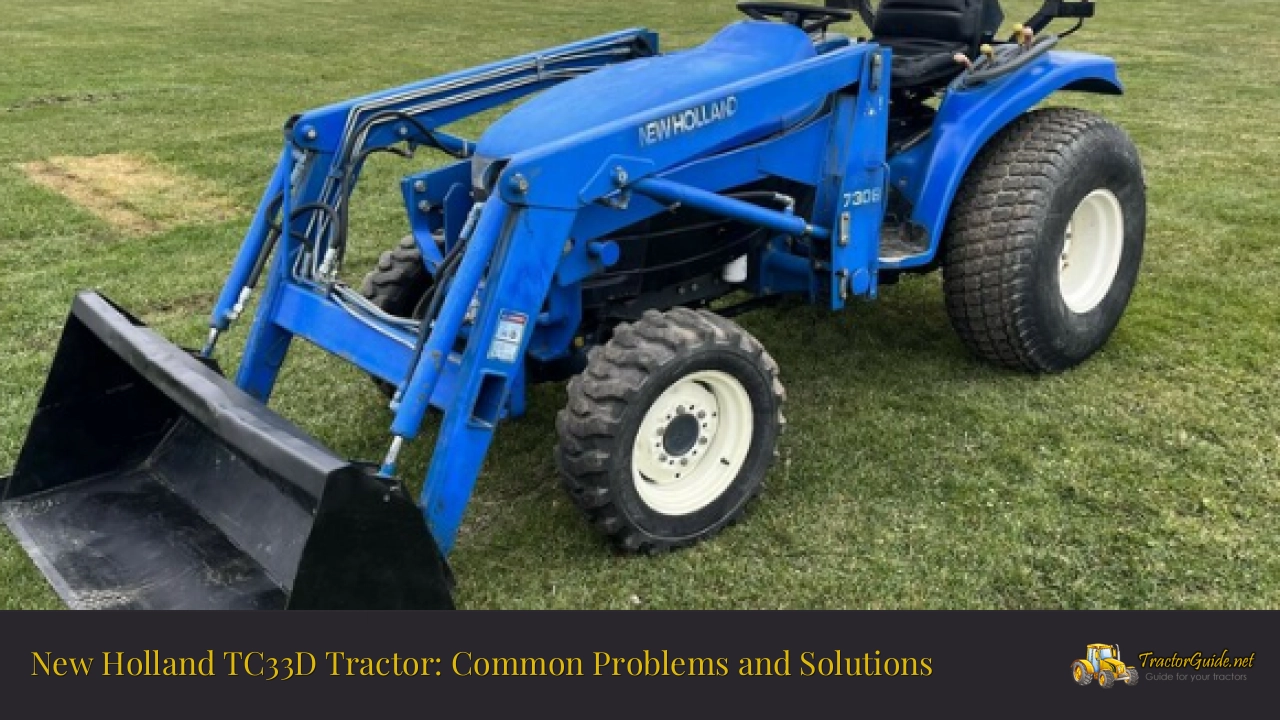The New Holland TC33D is a compact utility tractor that has been a popular choice for small farm operations, landscaping businesses, and hobby farmers since its introduction in the early 2000s. Known for its versatility and reliability, the TC33D nonetheless can experience issues that require attention and maintenance. This comprehensive guide will explore common problems faced by TC33D owners, provide detailed troubleshooting steps, and offer practical solutions to keep your tractor running smoothly.
Overview of the New Holland TC33D
Before diving into specific problems, let’s review the key specifications of the New Holland TC33D:
| Specification | Details |
|---|---|
| Engine | 3-cylinder diesel, 33 HP |
| Transmission | Hydrostatic or Gear (12×12) |
| PTO | Independent, 540 RPM |
| Hydraulics | Open center, 8.7 GPM |
| 3-Point Hitch | Category I |
| Weight | Approximately 3,000 lbs |
| Production Years | 2001-2006 |
Common Problems and Solutions
Hydraulic System Issues
The hydraulic system is crucial for the TC33D’s operation, powering everything from the three-point hitch to the power steering. Common hydraulic problems include:
Slow or Unresponsive Hydraulics
Symptoms:
- Slow lift times for attachments
- Weak or inconsistent hydraulic power
Causes:
- Low hydraulic fluid levels
- Contaminated hydraulic oil
- Worn hydraulic pump
- Clogged hydraulic filter
Solutions:
- Check and top up hydraulic fluid
- Replace hydraulic oil and filter
- Inspect and potentially replace the hydraulic pump
Hydraulic Leaks
Symptoms:
- Visible oil spots under the tractor
- Decreased hydraulic performance
Causes:
- Worn seals or O-rings
- Loose fittings
- Damaged hydraulic lines
Solutions:
- Identify the source of the leak
- Replace worn seals or O-rings
- Tighten loose fittings
- Replace damaged hydraulic lines
Engine Problems
The TC33D’s engine is generally reliable, but it can face issues, especially as it ages:
Hard Starting or Failure to Start
Symptoms:
- Engine cranks but doesn’t start
- Excessive cranking required
Causes:
- Fuel system issues (clogged filters, air in lines)
- Weak or dead battery
- Faulty glow plugs
Solutions:
- Check and replace fuel filters if necessary
- Bleed air from fuel lines
- Test and replace the battery if needed
- Inspect and replace faulty glow plugs
Loss of Power
Symptoms:
- Reduced engine performance
- Black exhaust smoke
Causes:
- Clogged air filter
- Fuel injection problems
- Turbocharger issues (if equipped)
Solutions:
- Clean or replace the air filter
- Service the fuel injection system
- Inspect and service the turbocharger
Transmission Problems
The TC33D offers both hydrostatic and gear transmission options, each with potential issues:
Hydrostatic Transmission Issues
Symptoms:
- Sluggish response
- Noise during operation
- Loss of power
Causes:
- Low hydraulic fluid
- Worn pump or motor
- Contaminated fluid
Solutions:
- Check and top up hydraulic fluid
- Flush and replace hydraulic oil
- Service or replace hydrostatic components
Gear Transmission Problems
Symptoms:
- Difficulty shifting gears
- Grinding noises
- Slipping out of gear
Causes:
- Worn clutch
- Low or contaminated transmission fluid
- Worn synchros or gears
Solutions:
- Adjust or replace clutch
- Change transmission fluid
- Repair or rebuild transmission
Electrical System Issues
Electrical problems can affect various tractor functions:
Battery Drainage
Symptoms:
- Dead battery after periods of non-use
- Dim lights
Causes:
- Faulty alternator
- Parasitic draw
- Old or damaged battery
Solutions:
- Test and replace the alternator if necessary
- Identify and fix sources of parasitic draw
- Replace the battery
Instrument Panel Malfunctions
Symptoms:
- Inaccurate gauge readings
- Non-functioning warning lights
Causes:
- Faulty sensors
- Wiring issues
- Damaged instrument cluster
Solutions:
- Test and replace faulty sensors
- Repair or replace damaged wiring
- Replace the instrument cluster if necessary
Maintenance Tips to Prevent Common Problems
Regular maintenance is key to preventing many of the issues discussed above:
- Follow the service schedule outlined in your operator’s manual.
- Change fluids and filters at recommended intervals.
- Regularly inspect belts, hoses, and electrical connections.
- Keep the tractor clean, especially the radiator and air intake.
- Store the tractor properly when not in use, preferably in a covered area.
When to Seek Professional Help
While many issues can be addressed by owners with basic mechanical skills, some problems require professional attention:
- Complex hydraulic system repairs
- Major engine overhauls
- Transmission rebuilds
- Electrical system diagnostics and repairs
Always consult your local New Holland dealer or a qualified tractor mechanic for issues beyond your expertise or comfort level.
Conclusion
The New Holland TC33D is a capable and reliable tractor when properly maintained. By understanding common problems and their solutions, owners can keep their machines running efficiently for years to come. Regular maintenance, prompt attention to issues, and proper operation will ensure that your TC33D continues to be a valuable asset for your farming or landscaping needs.
FAQs
What is the most common hydraulic issue with the New Holland TC33D?
Low hydraulic fluid levels and contaminated oil are the most frequent hydraulic problems. Regular fluid checks and changes can prevent many issues.
How often should I change the oil in my TC33D?
Engine oil should be changed every 100 hours or annually, whichever comes first. Always refer to your operator’s manual for specific maintenance schedules.
Why is my TC33D’s hydrostatic transmission not responding properly?
Sluggish hydrostatic transmission response is often due to low hydraulic fluid or contaminated oil. Check fluid levels and quality first before considering more serious issues.
What causes the TC33D to have starting problems in cold weather?
Cold weather starting issues are often related to glow plug problems or fuel gelling. Ensure glow plugs are functioning and use winter-grade diesel fuel in cold climates.
How can I improve the fuel efficiency of my New Holland TC33D?
Regular maintenance, proper tire inflation, and avoiding unnecessary idling can significantly improve fuel efficiency. Also, match the tractor’s power to the task at hand to avoid overworking the engine.
